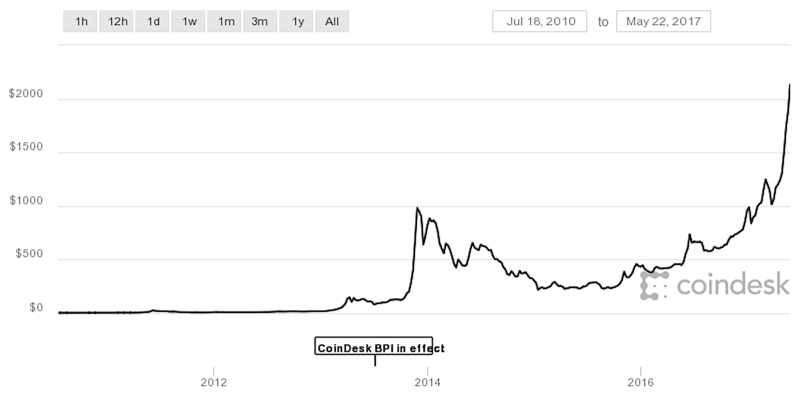Is the $2000 high a cause for concern or glee?
Exploring Bitcoin’s recent growth and whether the positives outweigh the negatives. This is a look on the possible future of Bitcoin. This weekend Bitcoin reached a new height of $2000 for one coin. This huge growth has both positives and negatives, with the possible repercussions being quite stron
Is the $2000 Bitcoin high a cause for concern or glee?
This weekend Bitcoin reached a new height of $2000 for one coin. This is an unprecedented growth, just a few weeks ago, at the end of April, one coin equaled $1300. This huge growth has both positives and negatives, with some concerns that this, coupled with the huge rise of other cryptocurrencies, will lead to a bubble that will have to burst. Bitcoin is plagued with a backlog of transactions, which requires larger fees. The smaller competitors are also seeing higher mining fees. Yet this growth obviously shows Bitcoin is attractive to a lot of people, and its history has shown it can bounce back from a fall.
Rises and falls are part of Bitcoin’s legacy. In 2010 10000 Bitcoins were used in the first “real world” transaction, to buy to pizzas. Now 10000 Bitcoins equal about 20 million bucks. In 2013, Bitcoin reached a high of about $1100, and was met with cheers about how well it was doing. Yet about a year later, it was below $500. A quick look at this graph below from coindesk shows the general trend. From its inception to 2013, there was little growth. Then in 2013 there was a huge amount of growth. This was followed by a decrease in 2014. Yet now, Bitcoin is at an all time high.

There are multiple causes for this growth. Fortune magazine argues there are three main reasons. First off, digital currencies are “in”, people are loosing interest and trust in banks and state backed currency. Bitcoin and other cryptocurrencies are also becoming very easy to use, unlike in 2010 when two users had to make a deal to exchange bitcoin for pizza, you can now use bitcoin with a variety of businesses, both large and small. Secondly, and this counteracts some of the idea of wanting to avoid state interference, the recent changing regulation by Japan to recognize Bitcoin as a legitimate currency. This action showed that some regulation is good, by changing the rules to recognize Bitcoin, but still having regulations in place, Japanese investors decided to cash in on the digital currency. Finally, there has been a lot of hype about Bitcoin in the media. With the Bitcoin rise because of the other factors, people are talking and thinking about Bitcoin more. This, added with the media attention on Bitcoin with the recent WannaCry ransomware, leads to increased want to use or look into Bitcoin.
Where will this all lead though? The last time Bitcoin rose, it fell within a year. Certainly, bitcoin has to fall eventually, the question is how much, quickly, and when. There is strong concern that the Bitcoin rise will be a bubble, that soon there will be a pop and lots of people will lose their money and trust in the system. This could have a disastrous effect on the future of Bitcoin, if it can’t recover as it did in 2016. This is further compounded by a lack of new merchant uses despite the rise in exchange. With the increased amount of stuck transactions and rising miner fees, people seem to be hording Bitcoin rather than using it to buy goods and services. Instead, this may be more like stock market speculation, buy low sell high rather than using Bitcoin as a real form of currency. This puts Bitcoin’s usage in jeopardy. Yet, it may not be the end of cyrptocurrencies. Although Bitcoin remains the largest player, its market share has decreased from around 80% of the market to a little under half in a short period of time. This means that a Bitcoin crash wouldn’t necessarily mean the end of digital cryptocurrencies nor blockchains.
Bitcoin doesn’t have to fall nor fail though. It is still unknown if this is in fact a bubble, digital currency can’t be measured like other assets to discover the real value, so no economist can say for sure. In addition, the return from the fall in 2014 shows that Bitcoin is resilient. In addition, if issues with extended wait times on transactions and high fees can be solved, for which there are several solutions but little want for cooperation, than Bitcoin would be in a very favorable position with a high exchange and a good infrastructure. Until that happens though, Bitcoin will remain in the possibility of peril.
In conclusion, Bitcoin is popular, which means its growing. This growth can be both a positive and a negative thing. Bubbles bursting is always bad, but if Bitcoin can stabilize itself it will continue occupying a strong position. Should you invest in Bitcoin? That’s anyone’s guess, but I’m quite sure Bitcoin will still be around and used extensively for years to come.


![Top 10 Tools and Resources for Crypto Research [2021]](/content/images/size/w720/max/800/1-kDyyUnRCD656bm2ny-jHag.png)

Comments ()